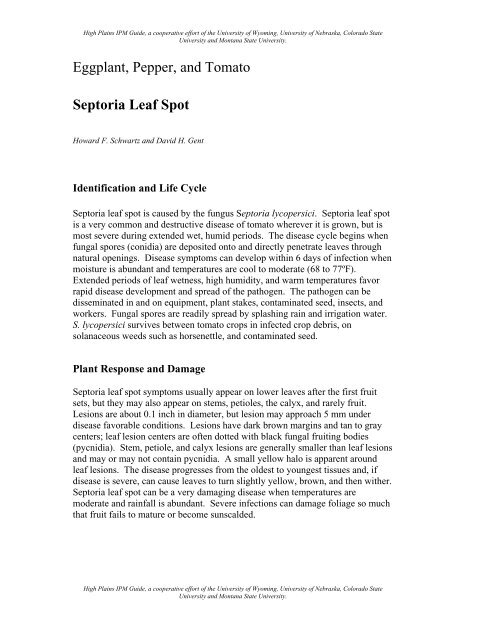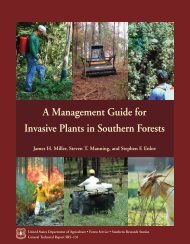Eggplant, Pepper, and Tomato XXIV - Septoria Leaf Spot
Eggplant, Pepper, and Tomato XXIV - Septoria Leaf Spot
Eggplant, Pepper, and Tomato XXIV - Septoria Leaf Spot
Create successful ePaper yourself
Turn your PDF publications into a flip-book with our unique Google optimized e-Paper software.
High Plains IPM Guide, a cooperative effort of the University of Wyoming, University of Nebraska, Colorado StateUniversity <strong>and</strong> Montana State University.<strong>Eggplant</strong>, <strong>Pepper</strong>, <strong>and</strong> <strong>Tomato</strong><strong>Septoria</strong> <strong>Leaf</strong> <strong>Spot</strong>Howard F. Schwartz <strong>and</strong> David H. GentIdentification <strong>and</strong> Life Cycle<strong>Septoria</strong> leaf spot is caused by the fungus <strong>Septoria</strong> lycopersici. <strong>Septoria</strong> leaf spotis a very common <strong>and</strong> destructive disease of tomato wherever it is grown, but ismost severe during extended wet, humid periods. The disease cycle begins whenfungal spores (conidia) are deposited onto <strong>and</strong> directly penetrate leaves throughnatural openings. Disease symptoms can develop within 6 days of infection whenmoisture is abundant <strong>and</strong> temperatures are cool to moderate (68 to 77ºF).Extended periods of leaf wetness, high humidity, <strong>and</strong> warm temperatures favorrapid disease development <strong>and</strong> spread of the pathogen. The pathogen can bedisseminated in <strong>and</strong> on equipment, plant stakes, contaminated seed, insects, <strong>and</strong>workers. Fungal spores are readily spread by splashing rain <strong>and</strong> irrigation water.S. lycopersici survives between tomato crops in infected crop debris, onsolanaceous weeds such as horsenettle, <strong>and</strong> contaminated seed.Plant Response <strong>and</strong> Damage<strong>Septoria</strong> leaf spot symptoms usually appear on lower leaves after the first fruitsets, but they may also appear on stems, petioles, the calyx, <strong>and</strong> rarely fruit.Lesions are about 0.1 inch in diameter, but lesion may approach 5 mm underdisease favorable conditions. Lesions have dark brown margins <strong>and</strong> tan to graycenters; leaf lesion centers are often dotted with black fungal fruiting bodies(pycnidia). Stem, petiole, <strong>and</strong> calyx lesions are generally smaller than leaf lesions<strong>and</strong> may or may not contain pycnidia. A small yellow halo is apparent aroundleaf lesions. The disease progresses from the oldest to youngest tissues <strong>and</strong>, ifdisease is severe, can cause leaves to turn slightly yellow, brown, <strong>and</strong> then wither.<strong>Septoria</strong> leaf spot can be a very damaging disease when temperatures aremoderate <strong>and</strong> rainfall is abundant. Severe infections can damage foliage so muchthat fruit fails to mature or become sunscalded.High Plains IPM Guide, a cooperative effort of the University of Wyoming, University of Nebraska, Colorado StateUniversity <strong>and</strong> Montana State University.
High Plains IPM Guide, a cooperative effort of the University of Wyoming, University of Nebraska, Colorado StateUniversity <strong>and</strong> Montana State University.Management ApproachesBiological ControlNo biological control strategies have been developed for <strong>Septoria</strong> leaf spot.Cultural ControlPlant high quality seed free from the <strong>Septoria</strong> leaf spot pathogen. Practice a 2-year or longer crop rotation between tomato crops. Eliminate weeds in <strong>and</strong>around tomato fields <strong>and</strong> rotation crops that can serve as alternate hosts for the<strong>Septoria</strong> leaf spot pathogen. Deeply bury crop debris soon after harvest to reducepathogen overwintering <strong>and</strong> survival. Promote rapid leaf drying by avoidingdense plantings, staking plants, <strong>and</strong> orientating rows parallel to the prevailingwind direction. Avoid overhead irrigation if possible, <strong>and</strong> time irrigations to endbefore dusk <strong>and</strong> avoid prolonged periods of leaf wetness. Reduce the contactbetween foliage <strong>and</strong> soil. Do not work in tomato fields when foliage is wet toreduce plant-to-plant spread of the fungus.Chemical ControlRegular fungicide applications may be necessary to control <strong>Septoria</strong> leaf spotwhen weather conditions are favorable for disease, but chemical controls are mosteffective when combined with as many cultural control strategies as possible.Product List for <strong>Septoria</strong> <strong>Leaf</strong> <strong>Spot</strong>:PesticideProduct peracreApplicationFrequency(days)RemarksCaptanCaptan 4F 4 pt 5-7 days 4 day REICaptan 50 2 lb 5-7 days 4 day REIChlorothalonilBravo 720, Ensign 1.5-3 pt 7-14 days Do not graze or feed debris tolivestock; 7 day PHIBravo Ultrex 1.7-2.2 lb 7-10 days Maximum of 18.3 pounds perseason; 0 day PHIHigh Plains IPM Guide, a cooperative effort of the University of Wyoming, University of Nebraska, Colorado StateUniversity <strong>and</strong> Montana State University.
High Plains IPM Guide, a cooperative effort of the University of Wyoming, University of Nebraska, Colorado StateUniversity <strong>and</strong> Montana State University.Bravo WeatherStik1.5-3.0 pt 7-10 days Maximum of 20 pints perseason; 0 day PHIEcho 720 1.5 -3.0 pt 7-10 days Maximum of 2.5 gallons perseason; 0 day PHIEcho 90DF 1.7-2.5 lb 7-14days Maximum of 16.67 pounds perseason; 0 day PHIEcho Zn 3-4 pt 7-10 days Maximum of 3.6 gallons perseason; 0 day PHIRidomil/Bravo 2-3lbs 14 days Maximum of threeapplications; 14 day PHICopper FungicidesChamp Dry Prill 1.33 lb 5-7 daysChamp Formula 2 1.33 pt 5-7 daysCopper-Count-N 4-6 pt 7 daysCuprofix Disperss 2.5-6 lb 7-10 daysKocide 101 1.5-3 lbs 5-7 daysKocide DF 1.5-3 lbs 5-7 daysKocide 4.5LF 1-2 pts 5-7 daysKocide 3000 0.75-1.75 lb 5-10 daysNordox 1.5-2.0 lb 7-10 daysTri Basic Copper 2-4 pt 7-10 days 1 day PHIEBDC, Copper EBDC, <strong>and</strong> EBDC/ZoxamideCuprofix DisperssMZ1.75-4.75 lb 3-10 days Maximum of 21 pounds perseason; 5 day PHIDithane DF 2-3 lb 7-10 days Maximum of 8.5 pounds perseason; 5 day PHI; use a nonionicsurfactant to improveperformanceGavel 75DF 1.5-2.0 lb 7-10 days Maximum of 4 (west ofRockies) to 8 (east of Rockies)applications or 16 pounds perseason; 5 day PHI; include anonionic surfactant to improveperformanceManeb 75 DF 1.5-2.0 lb 7-10 days Maximum of 8.0 pounds perseason; 5 day PHIManex 80W 1.5-2.0 lb 7-10 days Maximum of 7.5 pounds perseason; 5 day PHIManex 1.2-2.4 qt 7-10 days Maximum of 16.8 quarts perseason; 5 day PHIManKocide 2.5-5.0 lb 3-10 days Maximum of 42.7 pounds perseason; 5 day PHIManzate 0.75-1.0 lb 3-7 days Maximum of 8.5 lbs perseason; 5 day PHIPenncozeb 80W 1.5-2.0 lb 7-10 days Maximum of 7.5 pounds perHigh Plains IPM Guide, a cooperative effort of the University of Wyoming, University of Nebraska, Colorado StateUniversity <strong>and</strong> Montana State University.
High Plains IPM Guide, a cooperative effort of the University of Wyoming, University of Nebraska, Colorado StateUniversity <strong>and</strong> Montana State University.season; 5 day PHI.Penncozeb 75DF 1.5-2.0 lb 7-10 days Maximum of 8.0 pounds perseason; 5 day PHI.Strobilurin <strong>and</strong> Strobilurin MixturesCabrio 8-12 oz 7-14 days Maximum of 6 applications or96 oz per season; Do not makemore than 2 applications beforealternating with a fungicidewith a different mode of action;0 day PHIFlint 2-3 oz 7-10 days Maximum of 4 applications or16 ounces per season; Rotatewith fungicides with a differentmode of action such as Manebor copper-containing products;3 day PHIQuadris 5-6.2 oz 5-14 days Maximum of 5 applications or1.15 quarts per season;Alternate Quadris withfungicides with different modesof action; 0 day PHITanos 8 oz 5-7 days Rotate <strong>and</strong> rotato withfungicides with a differentmode of action such aschlorothalonil or mancozeb;Maximum of 72 ounces perseason; 3 day PHIThe information herein is supplied with the underst<strong>and</strong>ing that no discrimination is intended <strong>and</strong> that listing of commercial products,necessary to this guide, implies no endorsement by the authors or the Extension Services of Nebraska, Colorado, Wyoming or Montana.Criticism of products or equipment not listed is neither implied nor intended. Due to constantly changing labels, laws <strong>and</strong> regulations, theExtension Services can assume no liability for the suggested use of chemicals contained herein. Pesticides must be applied legallycomplying with all label directions <strong>and</strong> precautions on the pesticide container <strong>and</strong> any supplemental labeling <strong>and</strong> rules of state <strong>and</strong> federalpesticide regulatory agencies. State rules <strong>and</strong> regulations <strong>and</strong> special pesticide use allowances may vary from state to state: contact yourState Department of Agriculture for the rules, regulations <strong>and</strong> allowances applicable in your state <strong>and</strong> locality.Categories: <strong>Eggplant</strong>, <strong>Pepper</strong>, <strong>Tomato</strong>, Disease, <strong>Septoria</strong> <strong>Leaf</strong> <strong>Spot</strong>Date: 04/01/2007High Plains IPM Guide, a cooperative effort of the University of Wyoming, University of Nebraska, Colorado StateUniversity <strong>and</strong> Montana State University.
















